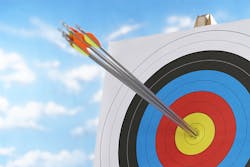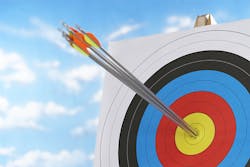The Difference Between Accuracy and Precision
I have a low tolerance for precise inaccuracy, though I’ve been in such situations more often than I care to admit. The upside is that it’s like an epiphany when awareness hits (or someone hits me with it).
I have a higher tolerance for my own accurate imprecision—at least I’m on the right track and have a good chance of hitting the target, and getting better at it.
This latter tolerance for grayness is a requirement for everyday, non-critical situations and interpersonal relationships. “Would you rather be right than happy?” is often the ultimate question you have to ask yourself. But “on the job,” there’s little room for gray when it comes to ballistic missiles or high-speed PC-board layout. Precisely hitting the wrong target or placement can be a problem.
This poses somewhat of a problem for engineers, who are born and bred with a penchant for low tolerance, high precision, and high accuracy, trained to seek all three, and then asked to mix with “regular” people.
You can go around correcting people and risk being marginalized by your friends and family, or learn to tolerate loose wording, poor math, marketing obfuscation and confusion, and blatant abuse and misuse of statistics and facts in politics, all of which leads to worst-case scenarios of imprecise inaccuracy. Aaargh!
This is where engineering can sometimes serve as a respite from the insanity, and maybe why engineers tend not to go into politics. Defining the requirements (target), then achieving those requirements precisely and within the allowed tolerance provides clarity of purpose that is both motivating and soothing.
For test-and-measurement engineers, the target is often pre-defined at the design stage, so now the trick is to ensure a precise, accurate measurement with the lowest possible tolerance, all while balancing cost and time to test.
For those new to the concepts, or need a quick reminder:
- Accuracy determines how close your measurement is to the actual signal value.
- Precision is the degree to which your measurements vary from one to the next
- Tolerance is the pre-determined, acceptable level of that variation in precision
Once you’re out of the lab, and it’s not a matter life and death, it’s still good to keep aiming for accuracy and precision, but loosen those tolerances, especially on the home front. Happy wife (spouse, husband, or partner doesn’t rhyme), happy life.
About the Author
Patrick Mannion Blog
Founder and Managing Director
Patrick Mannion is Founder and Managing Director of ClariTek, LLC, a high-tech editorial services company. After graduating with a National Diploma in Electronic Engineering from the Dundalk Institute of Technology, he worked for three years in the industry before starting a career in b2b media and events. He has been covering the engineering, technology, design, and the electronics industry for 25 years. His various roles included Components and Communications Editor at Electronic Design and more recently Brand Director for UBM's Electronics media, including EDN, EETimes, Embedded.com, and TechOnline.

